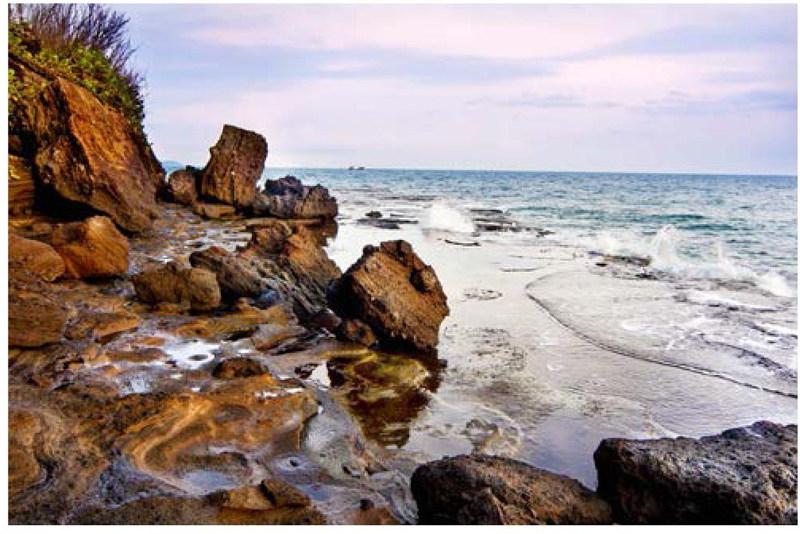Beihai: An Appealing Sapphire in South China
2022-07-22ChenZhiying
Chen Zhiying






At the southernmost point of Guangxi Zhuang Autonomous Region nestles a tropical paradise called Beihai. The name literally means “north of the sea”, which precisely reveals its geographical location and natural environment. Embraced by sea from three sides, Beihai is rich in marine landscapes and resources. Besides the silvery beaches, shimmering waters, and delectable seafood, it also boasts some niche scenic spots like Weizhou island, Golden Bay Mangrove Park, and Qiaogang town. Fascinating natural scenery and small fishing towns with exotic flavors combined make it a destination of great attractiveness to tourists around the world.
Weizhou island
— Masterpiece made by nature
In the vast southern sea of Beihai dot many tranquil and beautiful islands, and the Weizhou island is one of them. As the youngest volcanic island in China, it has amazing landforms shaped by the power of nature. Once stepping on the island, one could easily find the trails left by nature and time, like cliffs and terraces formed by rocks molten and compressed in volcanic eruptions, caves and trenches eroded by sea currents and waves, and pillars in various shapes. All these together create a unique ocean landscape, giving tourists a sumptuous visual feast. On the cliffs and hills cover the luxuriant forests. Looking down from afar, the whole island resembles a green jade floating on the sea. With such primitive and unspoiled natural landscapes, the island is an idyllic place to relax and get away from the hustle and bustle of the city. Imaging walking on the soft carpet made of sand, enjoying the cool breeze from the sea, and looking at the blue water blending into the sky, you can fully indulge yourself in the magical world created by nature. No wonder that the island was reputed as “Penglai fairy island”.
Mangrove
— Forest grows on the ocean
In the Golden Bay Mangrove Park, a vast area of lush green plants stretch unbroken for miles. It is called mangrove, a tree grows along coast in tropical areas. Unlike other trees that would stand permanently in one place if not damaged by natural or man made disasters, at some particular time the mangrove will disappear. That’s because it grows in the intertidal zone where the sea rushes to the shore. When the tide rises, the trees will hide themselves in the surging sea, leaving a small part of its dense canopy above the sea water; it is not until the tide falls that it shows the true look to people, which just like a kid playing hide and seek with his mother, or a shy girl gradually lifting her veils. Of course we can draw on our imagination and think in a good way. However, reality is always more cruel than what’s in our minds. Growing in intertidal zone means the mangrove has to experience two different, but both harsh environments in a day: soaking in high-saline seawater at high tides, standing under the scorching sun against the blowing wind at low tides. Although under such severe situation, the trees are still vibrant and vigorous.
Not only being able to survive well in bad condition, but the mangrove can also provide a cozy shelter and sufficient food for thousands of egrets. Therefore, the view of various kinds perching and hovering is often seen in this place. If you happen to visit here during sunset, you may see the scene depicted in Tang poet Wangbo’s A Tribute to King Teng’s Tower: “Egrets fly against the evening glow into distance, autumn rivers share similar hues with the vast sky.” Here, you can not only enjoy the poetic scenery but also reconsider the meaning of life.
Qiaogang town
— Exuding unique exotic flavors
Qiaogang is a small fishing town located Yinhai District of Beihai. It was a deserted beach over 40 years ago. In 1978, affected by some turmoils, a large number of overseas Chinese were forced to leave. In that year, they brought their family back to this deserted beach and began to live in Beihai, and the name of “Qiaogang” thus (port inhabited by overseas Chinese) came into being. After decades of continuous development, Qiaogang has taken on a new look. Its beach, custom street, and fishing market are well-known far and wide, attracting tourists to come and go. The town itself becomes a must-have place when travel to Beihai.
No matter the island, the mangrove, or the fishing town is only an epitome of Beihai scenery. The city opens its arms and waits for your exploration.
1. Mangrove is called “Hong Shu Lin” in Chinese, literally meaning red forest. The reason why it gets the name is that the tree in rich in tannins which make its trunk and bark appear red.
2. Mangrove is reputed as the “ocean guardian” as it protect marine biodiversity, safeguard coastal areas from erosion and storm surges, and improve the marine environment.
3. When the tide falls, small creatures such as oysters and snails could be found sticking on the branches of the mangrove.
杂志排行
中国-东盟博览(政经版)的其它文章
- Rongshui Miao Batiks: World of Blue and White
- Opportunities for Foreign Investors in Vietnam’s Coffee Industry
- Singapore to Reap Long-Term Benefits Under RCEP
- Green Building Materials Industry and CAEXPO Leverage Each Other’s Momentum
- From the Tonlé Sap Lakeside to the Dining Tables in China: Cambodian Rice in the CAEXPO
- Minister of Tourism, Arts, and Culture of Malaysia: Malaysia is Looking Forward to Cooperating With China in the Cultural and Creative Industry
